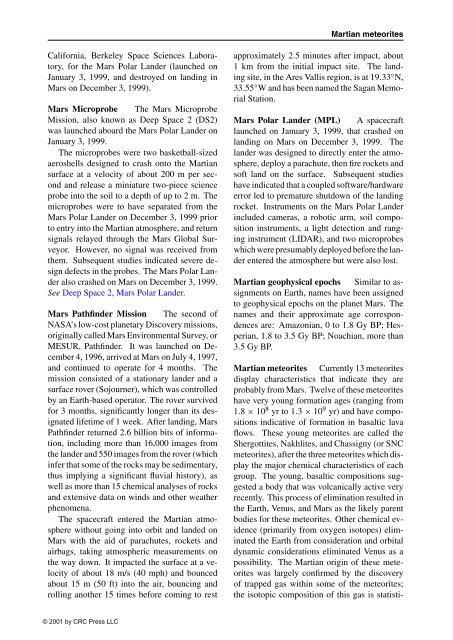DICTIONARY OF GEOPHYSICS, ASTROPHYSICS, and ASTRONOMY
DICTIONARY OF GEOPHYSICS, ASTROPHYSICS, and ASTRONOMY
DICTIONARY OF GEOPHYSICS, ASTROPHYSICS, and ASTRONOMY
You also want an ePaper? Increase the reach of your titles
YUMPU automatically turns print PDFs into web optimized ePapers that Google loves.
California, Berkeley Space Sciences Laboratory,<br />
for the Mars Polar L<strong>and</strong>er (launched on<br />
January 3, 1999, <strong>and</strong> destroyed on l<strong>and</strong>ing in<br />
Mars on December 3, 1999).<br />
Mars Microprobe The Mars Microprobe<br />
Mission, also known as Deep Space 2 (DS2)<br />
was launched aboard the Mars Polar L<strong>and</strong>er on<br />
January 3, 1999.<br />
The microprobes were two basketball-sized<br />
aeroshells designed to crash onto the Martian<br />
surface at a velocity of about 200 m per second<br />
<strong>and</strong> release a miniature two-piece science<br />
probe into the soil to a depth of up to 2 m. The<br />
microprobes were to have separated from the<br />
Mars Polar L<strong>and</strong>er on December 3, 1999 prior<br />
to entry into the Martian atmosphere, <strong>and</strong> return<br />
signals relayed through the Mars Global Surveyor.<br />
However, no signal was received from<br />
them. Subsequent studies indicated severe design<br />
defects in the probes. The Mars Polar L<strong>and</strong>er<br />
also crashed on Mars on December 3, 1999.<br />
See Deep Space 2, Mars Polar L<strong>and</strong>er.<br />
Mars Pathfinder Mission The second of<br />
NASA’s low-cost planetary Discovery missions,<br />
originally called Mars Environmental Survey, or<br />
MESUR, Pathfinder. It was launched on December<br />
4, 1996, arrived at Mars on July 4, 1997,<br />
<strong>and</strong> continued to operate for 4 months. The<br />
mission consisted of a stationary l<strong>and</strong>er <strong>and</strong> a<br />
surface rover (Sojourner), which was controlled<br />
by an Earth-based operator. The rover survived<br />
for 3 months, significantly longer than its designated<br />
lifetime of 1 week. After l<strong>and</strong>ing, Mars<br />
Pathfinder returned 2.6 billion bits of information,<br />
including more than 16,000 images from<br />
the l<strong>and</strong>er <strong>and</strong> 550 images from the rover (which<br />
infer that some of the rocks may be sedimentary,<br />
thus implying a significant fluvial history), as<br />
well as more than 15 chemical analyses of rocks<br />
<strong>and</strong> extensive data on winds <strong>and</strong> other weather<br />
phenomena.<br />
The spacecraft entered the Martian atmosphere<br />
without going into orbit <strong>and</strong> l<strong>and</strong>ed on<br />
Mars with the aid of parachutes, rockets <strong>and</strong><br />
airbags, taking atmospheric measurements on<br />
the way down. It impacted the surface at a velocity<br />
of about 18 m/s (40 mph) <strong>and</strong> bounced<br />
about 15 m (50 ft) into the air, bouncing <strong>and</strong><br />
rolling another 15 times before coming to rest<br />
© 2001 by CRC Press LLC<br />
Martian meteorites<br />
approximately 2.5 minutes after impact, about<br />
1 km from the initial impact site. The l<strong>and</strong>ing<br />
site, in the Ares Vallis region, is at 19.33 ◦ N,<br />
33.55 ◦ W <strong>and</strong> has been named the Sagan Memorial<br />
Station.<br />
Mars Polar L<strong>and</strong>er (MPL) A spacecraft<br />
launched on January 3, 1999, that crashed on<br />
l<strong>and</strong>ing on Mars on December 3, 1999. The<br />
l<strong>and</strong>er was designed to directly enter the atmosphere,<br />
deploy a parachute, then fire rockets <strong>and</strong><br />
soft l<strong>and</strong> on the surface. Subsequent studies<br />
have indicated that a coupled software/hardware<br />
error led to premature shutdown of the l<strong>and</strong>ing<br />
rocket. Instruments on the Mars Polar L<strong>and</strong>er<br />
included cameras, a robotic arm, soil composition<br />
instruments, a light detection <strong>and</strong> ranging<br />
instrument (LIDAR), <strong>and</strong> two microprobes<br />
which were presumably deployed before the l<strong>and</strong>er<br />
entered the atmosphere but were also lost.<br />
Martian geophysical epochs Similar to assignments<br />
on Earth, names have been assigned<br />
to geophysical epochs on the planet Mars. The<br />
names <strong>and</strong> their approximate age correspondences<br />
are: Amazonian, 0 to 1.8 Gy BP; Hesperian,<br />
1.8 to 3.5 Gy BP; Noachian, more than<br />
3.5 Gy BP.<br />
Martian meteorites Currently 13 meteorites<br />
display characteristics that indicate they are<br />
probably from Mars. Twelve of these meteorites<br />
have very young formation ages (ranging from<br />
1.8 × 10 8 yr to 1.3 × 10 9 yr) <strong>and</strong> have compositions<br />
indicative of formation in basaltic lava<br />
flows. These young meteorites are called the<br />
Shergottites, Nakhlites, <strong>and</strong> Chassigny (or SNC<br />
meteorites), after the three meteorites which display<br />
the major chemical characteristics of each<br />
group. The young, basaltic compositions suggested<br />
a body that was volcanically active very<br />
recently. This process of elimination resulted in<br />
the Earth, Venus, <strong>and</strong> Mars as the likely parent<br />
bodies for these meteorites. Other chemical evidence<br />
(primarily from oxygen isotopes) eliminated<br />
the Earth from consideration <strong>and</strong> orbital<br />
dynamic considerations eliminated Venus as a<br />
possibility. The Martian origin of these meteorites<br />
was largely confirmed by the discovery<br />
of trapped gas within some of the meteorites;<br />
the isotopic composition of this gas is statisti-<br />
305
















